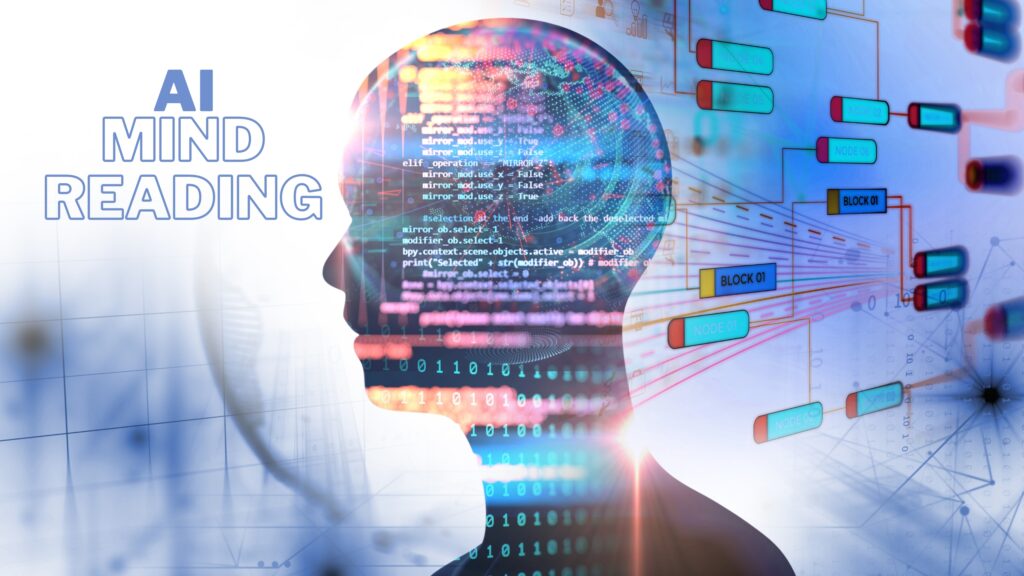Introduction
With a recent advancement in mind-reading technology, the wonders of artificial intelligence have expanded to new heights. Using functional magnetic resonance imaging (fMRI) to interpret continuous language from an individual’s brain activity, scientists have successfully constructed a language parser similar to ChatGPT. This ground-breaking discovery could help people with neurological disorders that impair speech communicate with one another. But as the research shows, there are serious ethical questions regarding personal privacy and the possibility of abuse when it comes to mind-reading gadgets.
The Breakthrough in Mind-Reading Technology
In a study led by researchers at the University of Texas in Austin, complex brain signals collected by fMRI were interpreted using an artificial intelligence model known as GPT-1. This non-invasive method showed an unprecedented ability to decipher continuous language straight from a person’s thoughts, in contrast to invasive procedures needing neurosurgery. This discovery has far-reaching effects that go well beyond science; it gives hope to those who have sadly lost their capacity to communicate as a result of illnesses or injuries.
Concerns About Privacy
While the potential benefits of this technology are immense, the team behind the decoder emphasizes the need for caution and ethical considerations. There’s a palpable fear of the potential misuse of mind-reading tools, particularly in the context of illegal government monitoring through brain-computer interfaces. In a Nature Neuroscience report, the authors underscore the critical importance of respecting mental privacy, even as they acknowledge the collaborative efforts of human subjects required for the tool to function effectively.
How the AI Tool Works
The fascinating journey of this AI tool begins with individuals spending hours immersed in stories within the confines of an fMRI machine. Through a meticulous process, the AI model, GPT-1, learns to associate specific words and phrases with the corresponding brain patterns recorded by fMRI. Armed with this knowledge, the tool is then able to interpret new stories, effectively converting spoken words into written text by analyzing the intricate dance of brain activity.
Distinguishing Features of the AI Tool
The study’s innovative approach distinguishes itself from established methods that involve invasive electrode implants in the brain. Instead of focusing solely on motor activities, such as mouth movements during speech, the AI tool analyzes the nuanced blood flow patterns captured by fMRI. This shift to higher-level semantics and meaning allows the tool to capture the essence of thoughts rather than merely transcribing exact words, adding a layer of sophistication to the mind-reading process.
Limitations and Future Prospect
While the current technology showcases promising results, there are practical challenges due to the unwieldy nature of experiments conducted within bulky fMRI machines. The researchers, however, express optimism about future iterations adapting to simpler tools like fNIRS sensors, potentially offering a more accessible solution for individuals with speech impairments. Despite these advancements, the pressing issue of privacy remains a key consideration on the path to wider adoption.
Privacy Issues and Ethical Dilemmas
As mind-reading AI tools advance, concerns about privacy intensify. The ability to decode human and animal brain waves for various outputs, such as text or images, raises profound ethical questions about the invasion of the most private asset — our thoughts. The potential for governments and corporations to misuse these technologies for surveillance or control amplifies the need to establish ethical boundaries and regulations to safeguard individual liberties.
The Ethical Dimension of Mind Reading
The blog delves deeper into the philosophical questions surrounding the ethical use of mind-reading technology. Drawing parallels to historical lessons about the mishandling of private information, it questions the wisdom of allowing unfettered access to our innermost thoughts. The fear of governments identifying potential crimes before they occur becomes a looming specter, urging the need for defined limits on the use of mind-reading technologies and robust ethical frameworks.
Current State of Mind-Reading Technology
The blog provides a comprehensive overview of the existing mind-reading technology landscape, emphasizing that true mind-reading capabilities still require complex and invasive procedures. Examples include experiments to transform brain waves into actionable outputs like text, images, or physical actions. Interestingly, it focuses attention to the contentious application of this technology by some governments, suggesting a possible diminution of individual freedoms and igniting a global discourse on the moral ramifications of such breakthroughs.
The Need for Ethical Guidelines
As mind-reading technology evolves, the blog strongly advocates for the establishment of clear ethical guidelines. It questions the unchecked access to private thoughts and the potential for mandatory invasions of mental privacy. To preserve human dignity and intellectual freedom globally, the function of international organisations like the UN Human Rights Council in identifying and defending “neuro-rights” is examined.
Conclusion
With artificial intelligence (AI) constantly testing beyond the boundaries of what was previously believed to be unattainable, mind-reading technological advances is at the cutting edge of technological advancement and controversies. The blog maintains on a balance between the wonders of mental understanding and the moral concerns raised by violations of privacy. The need for strict ethical norms is growing as society struggles with the significant ramifications of these technological breakthroughs. The final idea is in line with Benjamin Franklin’s wisdom, warning against abandoning fundamental liberty for a momentary sense of security and advising society to proceed cautiously when utilizing AI mind reading.
Frequently Asked Questions
What is AI mind reading?
– AI mind reading involves using advanced technology, like functional MRI and AI models, to interpret and convert brain activity into understandable text, potentially aiding those with speech impairments.
How does the AI tool work?
– The tool, GPT-1, analyzes brain patterns recorded by fMRI while individuals listen to stories, associating specific words with corresponding brain activity, offering a breakthrough in non-invasive language decoding.
What are the privacy concerns?
– Privacy concerns arise from the potential misuse of mind-reading tools for illegal monitoring, prompting the need for ethical guidelines to protect mental privacy.
Can AI decode thoughts accurately?
– The AI tool captures the gist of thoughts, not exact words, working at the level of ideas and semantics rather than low-level motor activities, offering a sophisticated approach to mind reading.
Are there limitations to the current technology?
– Yes, experiments are currently conducted in bulky fMRI machines, posing practical challenges. However, researchers foresee adapting the technology for use with simpler tools like fNIRS sensors in the future.
Why is ethical consideration crucial?
– Ethical considerations are essential to prevent potential misuse of mind-reading technology, ensuring the protection of individual liberties and upholding the right to mental privacy.



